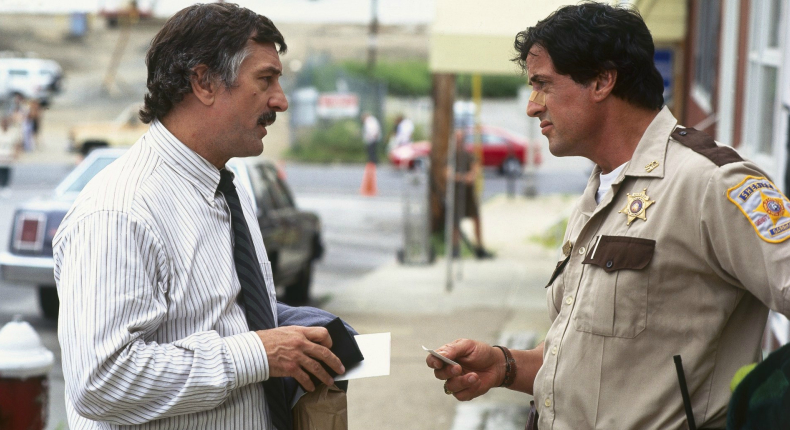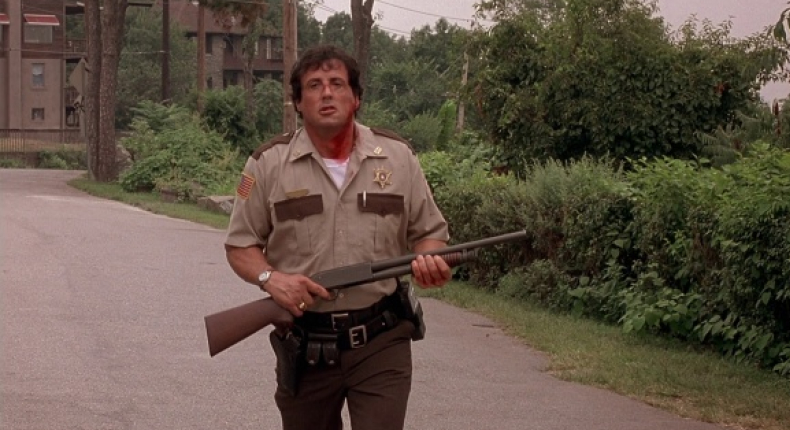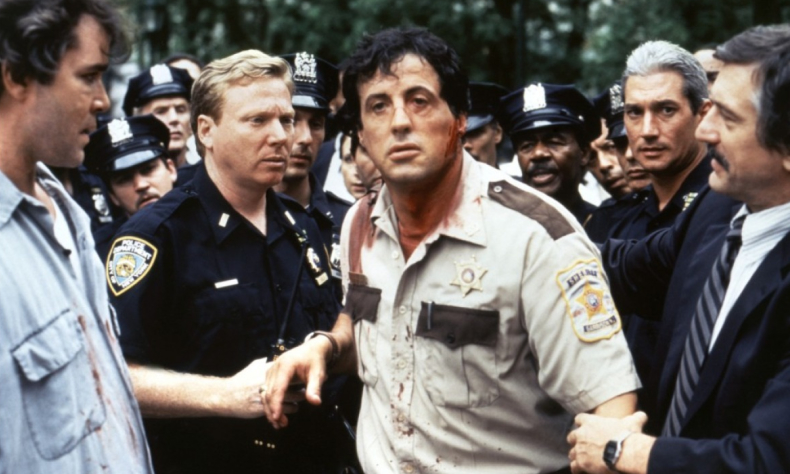Why Urban Western Cop Land is a Masterpiece | 20 Years On
My initial reaction on seeing Cop Land for the very first time was “why can’t every film be like Cop Land?”. The central characters are so well defined, the writing is so strong and the direction so clear that you have to wonder why films like Cop Land can’t be held up as an example of how a film should be made, not could be made.
Cop Land details the events in Garrison, a town populated with corrupt cops and built on mob money, once a local police officer kills two unarmed gangbangers on the George Washington Bridge and his friends try cover it up. Garrison, nicknamed “Cop Land” is policed by Sheriff Freddy Heflin (Sylvester Stallone), a perennially depressed lawman, a police force reject, who laments the choices he made in life to get him to this point. He is loveable but lost, always looking for that little bit of respect or status that his corrupt friends have and abuse. He turns a blind eye to their underhand ways, he ignores it until he can’t ignore it any more, until the fallout from the shootout comes knocking on his door.

Cop Land was a low budget film back in 1997, made for $20 million dollars, that somehow starred Sylvester Stallone, Harvey Keitel, Robert De Niro and Ray Liotta. At this stage in his career Stallone was commanding close to $20 million per film on his own. He was an action star, not a character actor, his film just previous to Cop Land was Daylight, with Assassins, Judge Dredd, Demolition Man and Cliffhanger not too far behind. The notion of him playing a half deaf, overweight, hangdog Sheriff in a sleepy little New York suburb was as far as can be from his Rocky/Rambo persona. How anyone thought of casting him as this slow witted, soft spoken lawman is beyond me, but what a stroke of genius it was. Though he shares screen time with De Niro and Keitel, two very talented and impressive actors, he absolutely burns them off the screen. Moe Tilden and Ray Donlan don’t hold a candle to Stallone’s Freddy Heflin.
While I can wax lyrical about Stallone in Cop Land, his is also a very frustrating performance. If he can do it in Cop Land then why did he waste so much time making Expendable movies, Get Carter, Driven, Bullet to the Head and at least another dozen subpar action flicks that the world has zero need for. It’s almost seems as if he can only pull off this kind of subtle, nuanced performance once every twenty years or so – Rocky (1976), Cop Land (1997), Creed (2015). Yet this is a performance to celebrate, Stallone is absolutely mesmerising. Everything about him is perfect, the way he tilts his head talking, the almost half-closed eyes, the awkward lumbering gait, the slow shy smile that he uses every once in a while, especially when talking to Liz, his lost love who was also instrumental in him losing his hearing. He just becomes Freddy Heflin, he lives in his skin and after a few minutes you don’t think of him as Rambo, this sad sack couldn’t possibly be the most macho of screen characters. That could be because he doesn’t look like himself. Stallone gained 40 pounds to play Freddy and in one scene his heavy belly is seen hanging out over the rim of his pants. Stallone believed in this film enough to physically change himself. While Rocky may be his defining character, Cop Land is his finest film.
While highlighting how good Stallone is and how capably he holds the screen with Keitel, De Niro and Liotta, one of Cop Land’s strongest points is its supporting cast. Robert Patrick, Peter Berg, Annabella Sciorra, Michael Rappaport, Noah Emmerich and Janeane Garofola each add a texture and a depth to the small-town characters they portray, Robert Patrick in particular. Most films are linear, they move forward to a certain point but Cop Land moves forward and expands at the same time, adding not only scope but breath to the plot, a depth developed by stories of unrequited love, mob money, corrupt cops, broken spirits, and every kind of malcontent you can think of. Every scene serves a purpose, not a frame is misspent, not a single word is wasted, everything is designed to build and create.
Take for instance the tail end of the scene where Freddy realises just how corrupt his little town of Garrison is and how dangerous Ray Donlan is. His Deputy, played wonderfully by Noah Emmerich says, “I don’t know about Ray, but not everybody in Garrison is a murderer”. Freddy, perusing the file he pilfered from Internal Affairs replies with, “No, they just keep their eyes closed and their mouths shut, just like me.” Now balance that against the scene that comes directly after, a family fun day at the local fair. The fairground is crawling with the bent cops that Freddy now wants to bring down. The Deputy is sitting in uniform in a box with a bucket of water just after falling over him and unseen voices laughing – the Deputy is ignoring the incipient, dangerous problem growing in the town, his eyes are now closed where Freddy’s have just opened. That scene is also used as a means of foreshadowing the terrific ending. Robert Patrick’s character, Jack Rucker, and Freddy share a moment at a pellet gun shoot out attraction. Freddy is perceived as the pushover, the easy touch. Freddy puts five shots through the bullseye and Rucker is stunned. This isn’t the Freddy he thought he knew, not the Freddy he had counted on. It’s such an amazingly subtle scene, so well realised by both actors. It’s also a theme that is continued on to the end of the climactic shootout. Ray lies dying and he looks up and speaks to Freddy, who just shot him but Freddy can’t hear anything. The entire sequence is shot in virtual silence and slow motion. Freddy tells Ray he can’t hear him, he can’t hear the shit that Ray is giving him but it’s not his choice. Where he once played at being a cop, he is one now, he’s done the hard work, the dirty work.

Cop Land almost reads like a soap opera in the sense that there are so many interwoven plot-lines, so many lives in this small little town overlapping. That is the beauty of James Mangold as writer and director, he can take so many loose threads and weave them together into a coherent whole. But he can do it with a confidence not found in many who, at this point in his career was making only his second feature film. Mangold writes and directs almost in Morse code, in dots and dashes. He’ll touch upon something, a plot point, with a scene, a sentence or sometimes even a single word and abandon it, returning to it later with a little more info than before. Think of Officer Glenn Tunney, he is mentioned only twice or three times in the film and often only in fleeting glimpses but the viewer learns through the character interactions that Glenn Tunney was murdered by Keitel’s Ray Donlan as Tunney was going to give evidence to the grand jury about how corrupt Ray was. It is masterful, it really is.
While saying that Cop Land has traces of soap opera in terms of the relationship structure and plotline overlaps, Cop Land is most definitely a certain type of film – a western. The final act looks and feels akin to High Noon or 3.10 to Yuma (a film Mangold would later remake), the lone lawman abandoned by his Deputies, trying to take in his prisoner as he stands up to the bad guys who control the town. Freddy is the anchor, he seems to be the last good man left in Garrison, as De Niro’s Moe Tilden says, “he’s a man looking for something to do.” Keeping Garrison safe was his job until he realised that he wasn’t even doing that, he was just protecting the bad guys. People don’t look at Freddy with affection but with sympathy or pity. Freddy is the guy who lost his hearing in one ear trying to save the girl he loved only for her to go and marry a cop, the very thing he wanted to be. But this pity is felt by Freddy as well, he pities himself, he wallows in it. Liz asks him why he never married, he answers with, “all the best girls were taken”. He loves Liz, but she doesn’t love him, and you can really sense his internal struggle – if he had let the girl of his dreams die then he would have gotten his dream job of wearing the blue of the NYPD.

There is a perfect scene at the start of the film where Freddy returns a stuffed toy lost by one of Liz’s children. Liz is talking to him from the kitchen, off screen, and Freddy is in the doorway. He steps in, into the sitting room and looks around at the kid’s toys, the family home and he catches sight of her husband’s photo on the wall in his police uniform and Freddy realises that this could have been his life had things been different. With an almost palpable sense of resignation he steps back to the door and to the outside. This is not his world. It’s just an amazing scene, so simple and so beautiful. Even at the very end you get the feeling that this is not going to change for Freddy, he is still going to feel that sense of sorrow but the scales have been lifted from his eyes and he sees the reality of his world. His life hasn’t changed, he still can’t become a cop and he’s destroyed the peace and prosperity of Garrison, but he’s done the right thing and that is what is important to Freddy, finally he is the “cop” he always wanted to be.
Cop Land is one of my favourite films of the 1990’s and it still stands the test of time, as good today as it was 20 years ago. Its themes of corruption, honesty and lack of identity, in an America led by Trump, are as relevant now as ever. If I had never seen Cop Land then I really would have missed out on something special. That something special is almost entirely Stallone, driven by his aching, honest and subtle performance as Freddy Heflin. Not too often has Stallone ever made me go “wow” but every single time I watch Cop Land I can’t help but stand back close to a bemused sense of awe and watch the man create something amazing.

